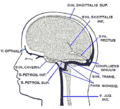Dura mater
Dura mater is a thick membrane that is the outermost of the three layers of the meninges that surround the brain and spinal cord. The other two meningeal layers are the pia mater and the arachnoid mater. The dura mater is responsible for keeping in the cerebrospinal fluid.
Structure[edit]
The dura mater is a thick, durable membrane, closest to the skull and vertebrae. The name "dura mater" derives from the Latin for "tough mother" (as a translation from Arabic) to denote its protective role. It is composed of two layers, the endosteal layer (closest to the skull), and the meningeal layer. The layers are normally fused, except in specific areas where they separate to form dural sinuses.
Function[edit]
The primary function of the dura mater is to protect the brain and spinal cord. It provides a supportive, protective enclosure for the brain and spinal cord and works in conjunction with the other meningeal layers, the cerebrospinal fluid, and the skull and vertebral column to safeguard the delicate tissues of the central nervous system.
Clinical significance[edit]
Inflammation of the dura mater, a condition known as dural inflammation, can result in severe headaches and other neurological symptoms. This can be caused by infection, direct injury, or as a result of surgery.
See also[edit]
References[edit]
<references />
|
|
|
-
Diagram of the meninges, including the dura mater
-
Illustration from Sobo 1909 showing the dura mater
-
Gray's Anatomy illustration of the dura mater
-
Gray's Anatomy illustration of the cranial dura mater
-
Medical illustration of the dura mater
-
Gray's Anatomy illustration of the spinal dura mater
-
Diagram of the cranial dura mater
-
Histological slide showing the dura mater
-
Histological slide showing the dura mater
-
Gross pathology of meningitis affecting the dura mater
Ad. Transform your life with W8MD's Budget GLP-1 injections from $75


W8MD offers a medical weight loss program to lose weight in Philadelphia. Our physician-supervised medical weight loss provides:
- Weight loss injections in NYC (generic and brand names):
- Zepbound / Mounjaro, Wegovy / Ozempic, Saxenda
- Most insurances accepted or discounted self-pay rates. We will obtain insurance prior authorizations if needed.
- Generic GLP1 weight loss injections from $75 for the starting dose.
- Also offer prescription weight loss medications including Phentermine, Qsymia, Diethylpropion, Contrave etc.
NYC weight loss doctor appointmentsNYC weight loss doctor appointments
Start your NYC weight loss journey today at our NYC medical weight loss and Philadelphia medical weight loss clinics.
- Call 718-946-5500 to lose weight in NYC or for medical weight loss in Philadelphia 215-676-2334.
- Tags:NYC medical weight loss, Philadelphia lose weight Zepbound NYC, Budget GLP1 weight loss injections, Wegovy Philadelphia, Wegovy NYC, Philadelphia medical weight loss, Brookly weight loss and Wegovy NYC
|
WikiMD's Wellness Encyclopedia |
| Let Food Be Thy Medicine Medicine Thy Food - Hippocrates |
Medical Disclaimer: WikiMD is not a substitute for professional medical advice. The information on WikiMD is provided as an information resource only, may be incorrect, outdated or misleading, and is not to be used or relied on for any diagnostic or treatment purposes. Please consult your health care provider before making any healthcare decisions or for guidance about a specific medical condition. WikiMD expressly disclaims responsibility, and shall have no liability, for any damages, loss, injury, or liability whatsoever suffered as a result of your reliance on the information contained in this site. By visiting this site you agree to the foregoing terms and conditions, which may from time to time be changed or supplemented by WikiMD. If you do not agree to the foregoing terms and conditions, you should not enter or use this site. See full disclaimer.
Credits:Most images are courtesy of Wikimedia commons, and templates, categories Wikipedia, licensed under CC BY SA or similar.
Translate this page: - East Asian
中文,
日本,
한국어,
South Asian
हिन्दी,
தமிழ்,
తెలుగు,
Urdu,
ಕನ್ನಡ,
Southeast Asian
Indonesian,
Vietnamese,
Thai,
မြန်မာဘာသာ,
বাংলা
European
español,
Deutsch,
français,
Greek,
português do Brasil,
polski,
română,
русский,
Nederlands,
norsk,
svenska,
suomi,
Italian
Middle Eastern & African
عربى,
Turkish,
Persian,
Hebrew,
Afrikaans,
isiZulu,
Kiswahili,
Other
Bulgarian,
Hungarian,
Czech,
Swedish,
മലയാളം,
मराठी,
ਪੰਜਾਬੀ,
ગુજરાતી,
Portuguese,
Ukrainian











